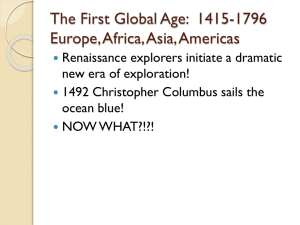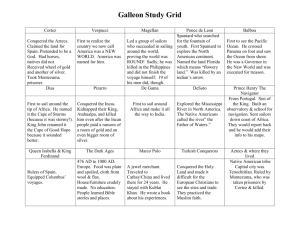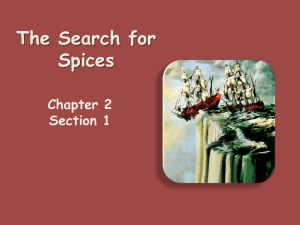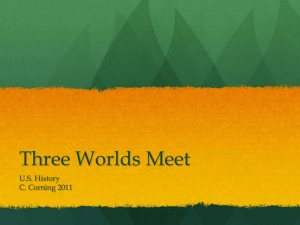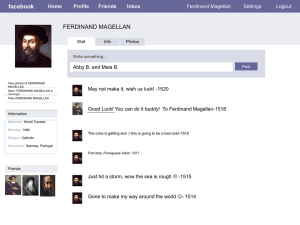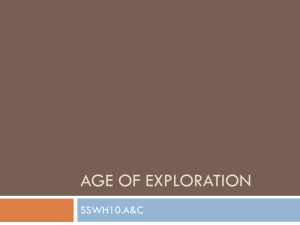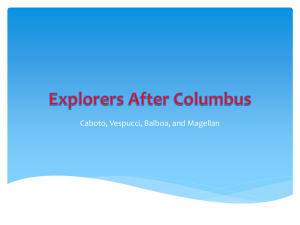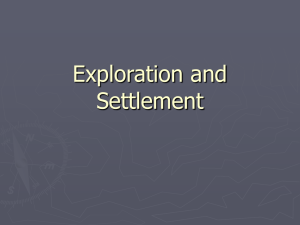Europe Begins to Explore PowerPoint Review - fchs
advertisement
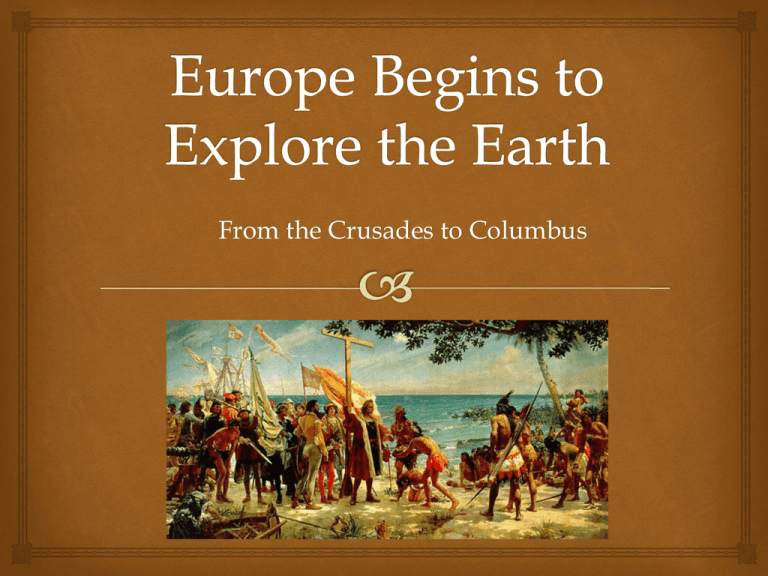
From the Crusades to Columbus The Crusades Although the Crusades were a time of conflict between Christians and Muslims, in the time between conflicts, trade increased dramatically. Spices, sugar, melons, tapestries, and silk were only a few of the luxuries sought out by Europeans. Because they were adept at shipbuilding, navigation and trade, Italian merchants profited from the trade with “East Asia.” Western European Nation States: Portugal, Spain, France and England would not emerge as separate nation states until the 1400s. Prior to that, they were disjointed kingdoms, as in the map above from the 12th Century. The Renaissance The Renaissance was originally a rediscovery of ancient poets, artists, geographer, mathematicians, and scientists. Soon, however, using ration though and scientific inquiry in the present became a priority. Improved maps and compasses, the astrolabe, and the improvement of ship design – particularly the threesail caravel – were all important developments to encourage European exploration. Henry “the Navigator” Henry “the Navigator” was the Prince of Portugal. He correctly deduced that by investing time and energy into the study of shipbuilding and navigation, his nation would benefit. Mapmakers had soon mapped out the Mediterranean and West Africa, and, although it took decades to complete, the Portuguese were on their way to dominating trade in the Atlantic World. The Portuguese Explorers Bartholomeu Dias As the first European explorer to reach the Cape of Good Hope – the southernmost point in Africa – Dias tested the limits of the known world in 1487. The mysterious currents of the region where three ocean met – the Atlantic, Indian, and Southern, required Dias to return home by the same route. Vasco de Gama Ten years later – and five years after Columbus had sailed across the Atlantic to encounter the “New World” – Vasco de Gama made his way to India by going around the tip of Africa. Thus, de Gama actually achieved what Columbus perceived that he had accomplished: he discovered a route to the Indies. African Kingdoms 400 A.D. The Empire of Ghana – This kingdom, which had converted to Islam when encountered by Arab traders, accumulated great wealth by taxing the salt and gold trade. 1200 A.D. The Empire of Mali – Again founded on the salt and gold trade, Mali rose to prominence under the famed leader Mansa Musa. The capital, Timbuktu, became a center of trade and Islamic scholarship In the 1460s A.D., the Kingdom of Songhai emerged and conquered Mali militarily. Songhai would continue to dominate West African trade until the late 1500s, when Moroccan troops crushed the nation militarily. Slavery in Africa It is frequently noted that slavery existed in Africa long before it existed in the Americas. This is undoubtedly true. Slavery existed in China, India, Greece, and Rome; indeed, it even existed in Native American communities. In Africa, slaves were taken in warfare and eight ransomed, or made a part of their new society. Arab traders and Europeans changed the nature of slavery by purchasing slaves in exchange for commodities. Portuguese plantation owners began using slaves for the brutal labor required on sugar plantations, resulting in high mortality rates. Slavery in the United States was unique because it was both race-based and hereditary. That is, if your mother was an enslaved person, you would inherit her condition of servitude. No. Virtually no one who had a rudimentary education believed that the world was flat during the late 15th Century. Columbus himself was quite certain the world was round. He thought it was much small than it actually is, though. The Spanish Monarchs: Ferdinand & Isabella The funding which Columbus received for his voyage of exploration was not excessive. Ferdinand and Isabella viewed his attempt to discover a new route to the Indies as a longshot bet. It paid off. Columbus enslaved the Taino people. In order to collect as much gold as possible from Hispaniola – and plant crops to support the large colony of settlers his second venture West brought – Columbus enslaved Native Americans. Disease and hard labor soon resulted in genocide. Amerigo Vespucci The Italian explorer Amerigo Vespucci actually mapped out the coastline of South America in 1499, confirming that what Columbus had discovered was not the Indies at all. Rather, it was a heretofore unknown continent to Europeans. Ponce de Leon Reportedly searching for the Fountain of Youth, Juan Ponce de Leon was the Spanish conquistador who explored Florida and claimed it for Spain. Vasco de Balboa Balboa crossed Central America from north to south near the present day isthmus of Panama. He was the first conquistador to set foot in the Pacific Ocean. He did not, however, have the distinction of naming the ocean. That honor would go to Ferdinand Magellan. Ferdinand Magellan Magellan was the leader of the expedition which would cross through what we call the Straits of Magellan today – at the southern most point in South America. Magellan and his crew would continue across the Pacific Ocean – which Magellan named – to the Philippine Islands. Magellan perished there. So, technically, Ferdinand Magellan did not circumnavigate the Earth. His crew did, becoming the first men in recorded history to do so. Hernan Cortes The advantages of the Spanish in Tenochtitlan – capital of the Aztec Empire – were many. Most notably: Disease Steel Weapons Armor Horses Mastiffs Written Communication Crossbows, guns, and cannons Quetzalcoatl? Smallpox Francisco Pizarro Pizarro and his men would conquer the Incans in 1532. Coronado Francisco Vasquez de Coronado and his men explored much of the Southwest during the 1540s. Reportedly seeking out the riches of the Seven Cities of Cibola, Coronado and his men are presumed to be the first Europeans to see the Grand Canyon and the Great Plains. Hernando de Soto Junipero Serro and the Spanish Conquest of California California was settled by the Spanish, as well, as we can tell from the names of the cities along the coast of our nation’s largest state. The Spanish claims to California would be maintained all the way up to the Mexican-American War in the 1840s, although they were not considered legitimate by anyone in North America at that point. Popé The Encomienda System The Spanish encomienda system formalized the enslavement of Native American peoples. The Spanish were obliged to attempt to Christianize all Native Americans and to pay some minimal wages to those who worked on the plantations or in the mines. The French Explorers Giovanni da Verrazano – Verrazano explored the east coast of North America from Newfoundland to present day New York city. Fruitlessly, he sought the Northwest Passage. Jacques Cartier – Cartier was the founder of the city of Montreal – in 1534. He made three return visits to explore the St. Lawrence seaway, seeking the Northwest Passage each time. Samuel de Champlain – established Quebec in 1608, which would become the center of New France in Canada. The Fur Trade The French colonization patterns in the New World were almost polar opposites of the Spanish. While the Spanish gave lip service to the ideas of proselytization by creating Las Leyes Nuevas and adopting fair rules with the encomienda system, the French actually lived by these ideals. Jesuit priests attempted to live among Native American societies and were far more patient and accepting of the unique interpretations of the Catholic faith which Native Americans articulated. Moreover, the French did not seek to establish large populations in their settlements. They were more concerned with trade and the acquisition of resources. The French Mississippi Louis Joliet & Jacques Marquette – more fur traders than explorers originally, Joliet and Marquette eventually discovered the source of the Mississippi River. The men claimed the Mississippi River Valley for France. Robert de la Salle sailed the length of the Mississippi River all the way to the river delta where New Orleans would eventually be established. By the end of the 17th Century the French had recognized the value of the farmland and the potential of the region for plantation agricultures. Soon, enslaved Africans were brought to the region to cultivate rice, indigo, and sugar cane.
